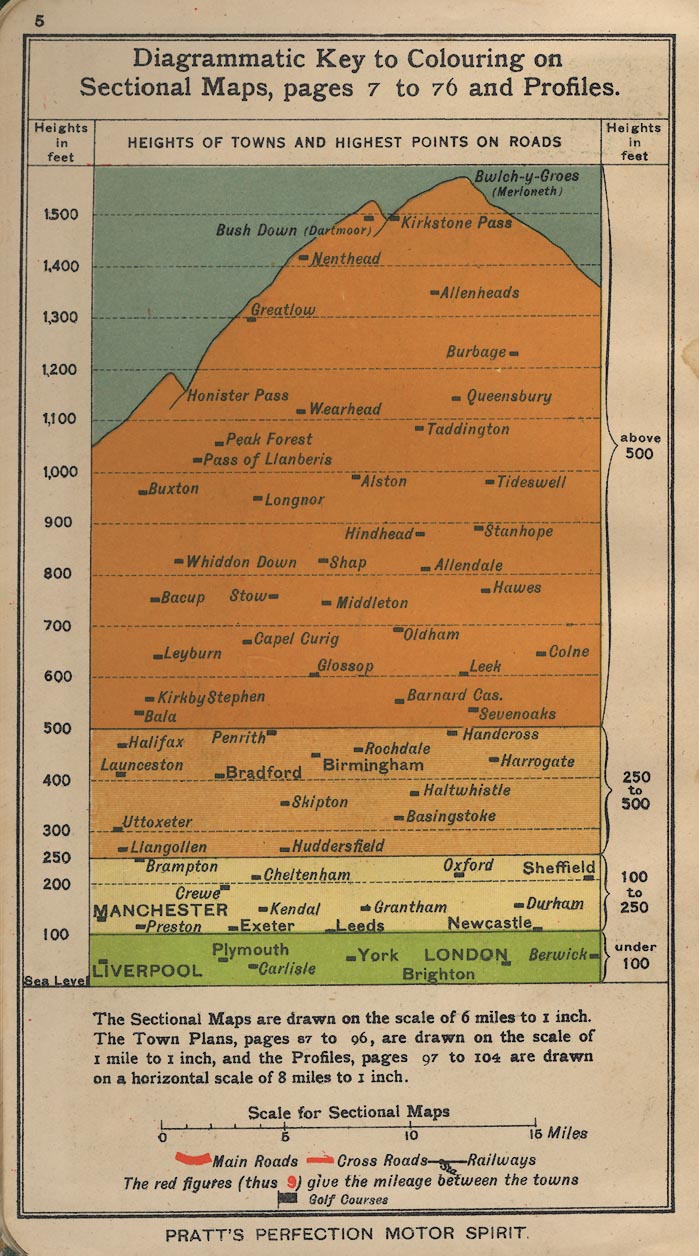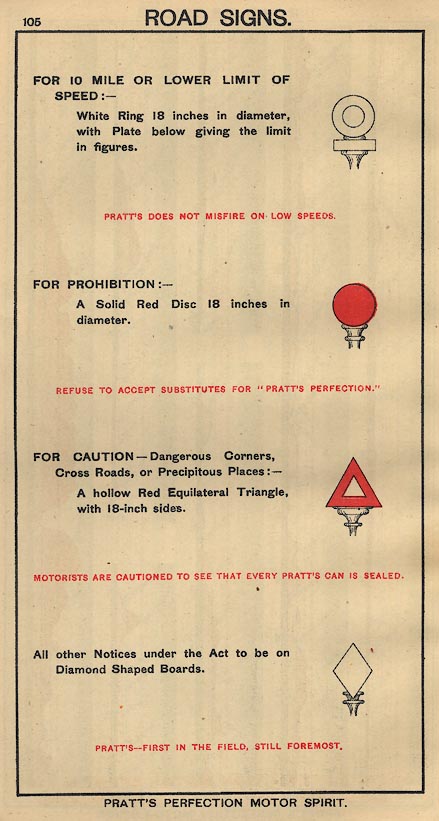



The dominant element of this is the:-
Diagrammatic Key to Colouring on Sectional Maps, pages 7 to 76, and Profiles.
Layer colouring is displayed as a mountain diagram, with a selection of places at their proper heights. The only Hampshire place is Basingstoke at about 325 feet. Map scales are declared:-
The Sectional Maps are drawn to a scale of 6 miles to 1 inch. The town plans, pages 87 to 96 are drawn on the scale 1 mile to 1 inch, and the Profiles, pages 97 to 104 are drawn on a horizontal scale of 8 miles to 1 inch.
Below is a scale line:-
Scale for Sectional Maps
and some map symbols:-
[bold red line] Main Roads [red line] Cross Roads [black line] Railways
The red figures (thus 9) give the mileage between the towns
[square black flag] Golf Courses
up is N

All the map have a piano key border around the open spread of two pages, which, printed separately, are designed as one map unit.
The page numbers for adjoining sheets are printed in a circle in the borders. For example, most of Hampshire is on pp.11-12, two landscape pieces. The adjoining sheets are 9 to the east, 29, 20, 31 to the north, 13,14 to the west. Sea is to the south.
scale

Scale for Sectional Maps
marked in miles to 5 then at 5 mile intervals. The 15 miles = 63.5 mm gives a scale 1 to 380160. The road map scale is about:-
1 to 380000
6 miles to 1 inch

50 [degrees] 40 [minutes]
1 [degree]
20 [minutes]
Reading as accurately as possible from the map
longitude, Winchester = 1d 18.6m W
which accords with a prime meridian at Greenwich; Winchester is usually taken as being 1d 18.4m W.
sea tinted
coast line
harbours

The sea area is printed blue, with some sea areas labelled, eg:-
The Solent
The coast line is not emphasised.
Harbours are clearly recognisable, but not labelled.

Above their estuaries, which are printed blue with the sea, rivers are drawn by a wiggly line tapering upstream. Some rivers are labelled, eg:-
Test
Itchen
layer colouring

Relief is shown by layer colouring, printed without contour lines at the edges. The layers do not have equal vertical intervals. The table of symbols on a preface page explains:-
Heights in feet
under 100 [green]
100 to 250 [yellow]
250 to 500 [pale orange]
above 500 [orange]
The bold colours give the road maps a jolly appearance. Hills, downs, etc are generally not labelled.
NEW FOREST
area is labelled.
town

WINCHESTER
WHITCHURCH
Larger towns might be labelled in a slightly larger, serifed, block caps; in Hampshire:-
SOUTHAMPTON
PORTSMOUTH
village
hamlet

Alton
Middle Wallop
road distances
gradient diagrams

The network of roads is drawn by solid red lines, broad and narrow for main road and cross roads (a surprisingly old fashioned term?). Distances between towns are marked beside roads by red figures. You have to be careful how distances are understood, from which place to which?
The pages after the road maps have gradient diagrams, road profiles, of a number of the main routes. The horizontal scale is about 8 miles to 1 inch; the base line marked and labelled at 5 mile intervals. The vertical scale is about 1100 feet to 1 inch; there are horizontal rules at 100, 250 and 500 feet, and the 'land' below the road line is layer coloured. Various places, settlements on hill tops, are labelled along the route. Each road profile is titled.

Page 105 illustrates types of four road sign:-

White ring; for a 10 mile per hour speed limit, or less.
Red disk; prohibition.
Red triangle; caution.
White diamond for other 'Notices under the Act'.
These signs are the first official road signs, defined by government legislation, the Motor Car Act 1903. There was a general speed limit of 20 miles an hour in 1903, so the lower speed restriction was all that was needed.
Page 106 gives a table giving the speed in miles per hour against the time for 1 mile. The times are in minutes and seconds from 1 min. 0 sec. in steps of 1 second, to 6 min. 0 sec, a range of speeds from 60 mph to 10 mph. This is particularly useful if there was still a general speed limit of 20 miles per hour!

Oakley Sta.

Only one miscellaneous feature is regularly marked, golf courses, by a small black rectangular flag on a low post.
 Pratt 1905
Pratt 1905